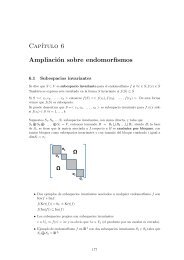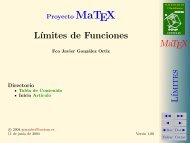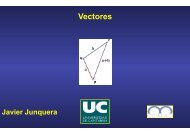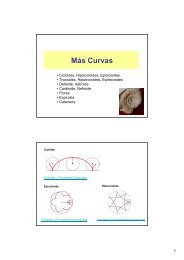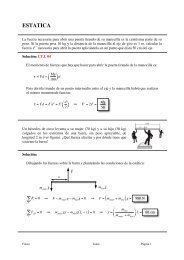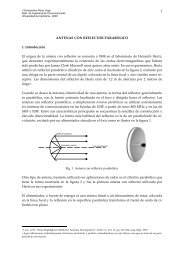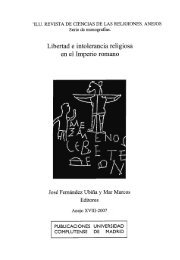Estimators based in adaptively trimming cells in the mixture model
Estimators based in adaptively trimming cells in the mixture model
Estimators based in adaptively trimming cells in the mixture model
You also want an ePaper? Increase the reach of your titles
YUMPU automatically turns print PDFs into web optimized ePapers that Google loves.
24<br />
22<br />
20<br />
18<br />
16<br />
14<br />
12<br />
10<br />
8<br />
6<br />
4<br />
5 10 15 20 25 30 35 40 45 50<br />
Figure 4: Plots show<strong>in</strong>g <strong>the</strong> 95% ellipses for <strong>the</strong> estimated distributions and sex of <strong>the</strong> Blue Crab Data<br />
set of Example 3.3.<br />
trimmed 2-means as <strong>the</strong> <strong>in</strong>itial region (lead<strong>in</strong>g to <strong>the</strong> colored po<strong>in</strong>ts), a separation threshold of u = 0.1,<br />
and a f<strong>in</strong>al trimm<strong>in</strong>g size of 5%. This time we have chosen a higher <strong>in</strong>itial trimm<strong>in</strong>g level than usually<br />
because, if not, <strong>the</strong> very elongated shapes of <strong>the</strong> groups could make impossible to choose a representative<br />
region of both populations <strong>based</strong> on two balls of <strong>the</strong> same radius.<br />
•<br />
Example 3.4 This example differs from <strong>the</strong> precedent ones by three ma<strong>in</strong> facts: It is <strong>based</strong> on a real<br />
data set, <strong>the</strong> data are univariate and <strong>the</strong> number of components <strong>in</strong> <strong>the</strong> <strong>mixture</strong> is unknown. Moreover<br />
<strong>in</strong> previous analysis it has been assumed as a simplification of <strong>the</strong> <strong>model</strong> that <strong>the</strong> subyacent populations<br />
have <strong>the</strong> same variance, a fact that enormously simplifies <strong>the</strong> problem by avoid<strong>in</strong>g s<strong>in</strong>gular solutions. In<br />
consequence, under such assumption, <strong>the</strong> use of restrictions is not necessary to obta<strong>in</strong> <strong>the</strong> estimators.<br />
The data, represented by <strong>the</strong> bars <strong>in</strong> Figure 5, are constituted by <strong>the</strong> lenght of 222 scallops caught <strong>in</strong> an<br />
area of 79 m 2 <strong>in</strong> Mercury Bay, New Zealand, and present a clear component of smaller shellfish conta<strong>in</strong><strong>in</strong>g<br />
<strong>the</strong> bulk of <strong>the</strong> observations and a more confused and spread out tail of larger animals. An additional<br />
trouble for <strong>the</strong> analysis is <strong>the</strong> scarce precission of <strong>the</strong> measurements, lead<strong>in</strong>g to many repetitions.<br />
This data set was first treated by Jorgensen, <strong>in</strong> [14], to <strong>in</strong>troduce some diagnostic statistics that<br />
permit <strong>the</strong> analysis of <strong>the</strong> <strong>in</strong>fluence of data <strong>in</strong> <strong>the</strong> estimation of a f<strong>in</strong>ite <strong>mixture</strong>. Jorgensen, argu<strong>in</strong>g<br />
from <strong>the</strong> fact that <strong>in</strong>dividual scallops have a dim<strong>in</strong>ish<strong>in</strong>g rate of l<strong>in</strong>ear growht, considers unlikely a great<br />
heterogeneity with<strong>in</strong> a cohort. Thus, if <strong>the</strong> data with<strong>in</strong> <strong>the</strong> range 62-82 mm constitutes one component,<br />
<strong>the</strong> rema<strong>in</strong><strong>in</strong>g data must constitute at least two. In <strong>the</strong> absence of o<strong>the</strong>r <strong>in</strong>formation, Jorgensen opted<br />
by fitt<strong>in</strong>g a <strong>mixture</strong> of three normal distributions with <strong>the</strong> same variance π 1 N(µ 1 , σ 2 ) + π 2 N(µ 2 , σ 2 ) +<br />
(1 − π 1 − π 2 )N(µ 3 , σ 2 ), not<strong>in</strong>g <strong>the</strong> excesive <strong>in</strong>fluence of <strong>the</strong> value 126 mm as well as <strong>the</strong> very scarce<br />
representation of <strong>the</strong> third (<strong>in</strong> importance) distribution.<br />
Later, <strong>in</strong> [16], Markatou <strong>in</strong>troduced <strong>the</strong> weighted likelihood approach <strong>in</strong> <strong>the</strong> framework of <strong>the</strong> estimation<br />
of f<strong>in</strong>ite <strong>mixture</strong>s, and worked two examples of <strong>mixture</strong>s of normal distributions <strong>in</strong> <strong>the</strong> real l<strong>in</strong>e<br />
with same variance. The weighted likelihood approach is <strong>based</strong> on weight<strong>in</strong>g <strong>the</strong> terms <strong>in</strong> <strong>the</strong> likelihood<br />
equation accord<strong>in</strong>g with a measure of discrepancy of <strong>the</strong> data with respect to <strong>the</strong> <strong>model</strong>. This procedure<br />
11




